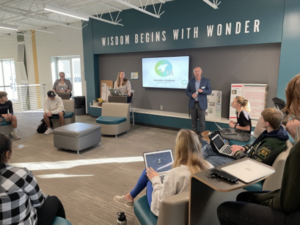6 Things That Learning Professionals Can Learn from Marketers

Marketers and learning designers share a lot of common ground, but at times may be reluctant to let this be stipulated. Confidently, I will assert that both professions endeavor to change behavior, and both are required to stay current in their disciplines to be truly successful in our dynamic world.
Nevertheless, there can seem to be a stigma about being a marketer – perhaps unkindly contributed to by television shows like Mad Men – which accepts that marketers are less academic and more “shill-like” than those who are involved in instructional design.
I am not afraid to confess that I am both a marketer and learning developer. My marketing hat allows me to spot interesting new technologies, trends and concepts that are changing behaviors, while helping me satisfy a personal need to be a lifelong learner.
While attending DevLearn a few years back, I found myself intrigued by presentations which touched the periphery of marketing’s “body of knowledge”. It struck me then, and remains with me even more today, that these disciplines can learn from each other.
While much more could be said about the parallels of learning design and marketing, here are six critical points that learning architects, designers and developers can borrow from marketing’s body of knowledge and practice:
Address learner motivations to get engagement
In my experience, learners often are mandated to participate in a learning program or course without a whole lot of intrinsic desire. For me, a classic example is health and safety training, often compulsory or compliance-based, but rarely “treasured”. Marketers, of course, spend much of their time working towards provoking the emotional response, knowing that about 75% of any “buying” decision (read “learning” decision and you’ll get the drift…) is dependent on emotional response.
So – we need learners to engage? Work to create a real, emotional sense of the problem that the learning will address and help the learner resolve. Include human impact statements and photo vignettes in your programs. When learners come to understand that the learning will address higher-order (aka emotional/self-actualization) benefits, they will be ready to engage more fully. And don’t miss the opportunity to “market” the course to the learners before the experience – after all, getting enthusiastic bums in seats is amongst our most important objectives as learning experts.
Be relevant
We know that web technologies have changed the attention span, the need for incredible hooks (as in, they are good!), and, increasingly, the ability to (perhaps with creep factor) personalize messages to highly targeted audiences. Much of this is to address another factor of engagement – relevance. It just feels better when it calls your name, when it “just in time” addresses a real need. Our learning programs need to be shaped by this same thinking that is prevailing in marketing – we need to deliver, just in time, that, what the learner needs to accomplish tasks and change behaviors. It is about simplifying the path to “Yes!”. It will require changing technologies in learning to effectively empower us, as learning developers, to that end. It will require more effort towards modularity and micro-learning. My group’s experiments with providing a sales team with a tool that can rip apart/amend/re-configure e-learning builds in advance of a learning call with physicians speaks to the potential of “delivering the right message” just in time.
Get your channels right
Not everyone is going to be willing to sit in a classroom. Not everyone is going to respond well to the “Next/Previous” approach to e-learning design. Marketers have, for years, been talking about channels – which include a large variety of ways to get messages to “buying” target audiences. You know channels too – print, audio, video, online, via television, via face to face interaction, using VILT. It is my opinion, however, that learning designers are far less conscious about channels – and stages of use of channels – than marketers tend to be. Marketers know that you match the message to the stage of the buying cycle, and then figure out what channels will get the message delivered most effectively. There are whole toolsets that help marketers figure out “channels” and “channel enablement”. Marketers also know that it is rarely effective to “set it and forget it”. Learning developers need to catch up with the savvy already in use by marketers about getting channels right. Sometimes, after all, a case study- based learning program will do far more for behavioral change than a “Previous/Next” throw of facts against the wall, hoping that something will stick.
Manage cognitive load
Marketers know that the human brain can only absorb so much, and since so many of the scenarios marketers advantage themselves of can be called micro-encounters – 30 second commercials, quarter page ads, billboards – they know that they must keep it to one or two key messages. This lesson is cleverly taught by Curly, the grizzled cowboy in the movie City Slickers – so if cowboys know it, why don’t we? In part, learning developers, myself included, know that there are desired behavioral change outcomes, and so we have to cram in everything to try to get people to change at least something. But the “spray and pray” approach to learning leads to fatigued learners and cognitive overload. Create “lean learning” (for inspiration, review some of the exceptional thought work on action mapping and action-based learning by Cathy Moore.) Pace your learners. Help them convert one or two things to behavior at a time. Create follow-up interactions by email, text messaging, surveys, or using tools like Mind Marker and Case Swarm. Learning is progressive – and marketers are perhaps better situated to understand and act on this than learning designers have been.
Get them trying out (“trialling”) behaviors quickly
In marketing, one of the most important practices is the implementation of a carefully-crafted Call to Action. To understand, go to an effective (and gorgeous! Get the aesthetics right!) website like Nike, and note the buttons inviting you to do something right now. For any learning program – we must begin with the end in mind, knowing what we want the learner to do. But how often do we, as learning developers, weakly call out the desired action because we’ve framed them with Bloom’s taxonomy, in complex language, as learning outcomes/objectives? How often do we let the learner clearly know that it is now their turn, that they need to go and try something. Practical exercises, simulations, case study challenges, games – all these get people doing something (preferably, the desired behaviors!) with immediacy. You need to act on this in your next learning program. (See, that was easy.)
Anticipate and handle the objections
Marketers and sales leaders spend a lot of time anticipating the barriers to adoption for their brands, products, solutions. They try to place themselves into the heads of potential/target clients, and they trial new pitches and messages with focus groups and small audiences of clients, to both see what works and to actively provoke objections. There are those who maintain that objections in selling are bad things. I, however, do not belong to that school, and believe that you really do want to know what will keep people from behavioral change. In our work as learning professionals, are you contemplating what aspects of any given program or course will inherently face barriers to behavioral change? Are you anticipating the objections? Are you trying both to pre-empt the objections, and provide in-program ways to help those who originate an objection get real answers (or at least find a way to explore their objections and be provided with a reframing)? Remember, someone convinced against her will is of the same opinion still.
Take some time in the next month to treat a friend or colleague who is a marketer to coffee or lunch, and ask “What’s new? What are you thinking about these days in marketing?” You just might find some real gems that will enhance your work and your personal development.
For more check out:
- What Should Be: 21 Questions About Learner Experience
- 10 Elements of Next-Gen Learner Experience (LX)
- Learning Experience Design vs. User Experience: Moving From “User” to “Learner”
Todd Kasenberg is the Principal at Guiding Star Communications and Consulting. Follow Todd on Twitter, @Guidingstarcc.
Stay in-the-know with all things EdTech and innovations in learning by signing up to receive the weekly Smart Update.







theophilus
I have learnt most important practices is the implementation of a carefully-crafted Call to Action